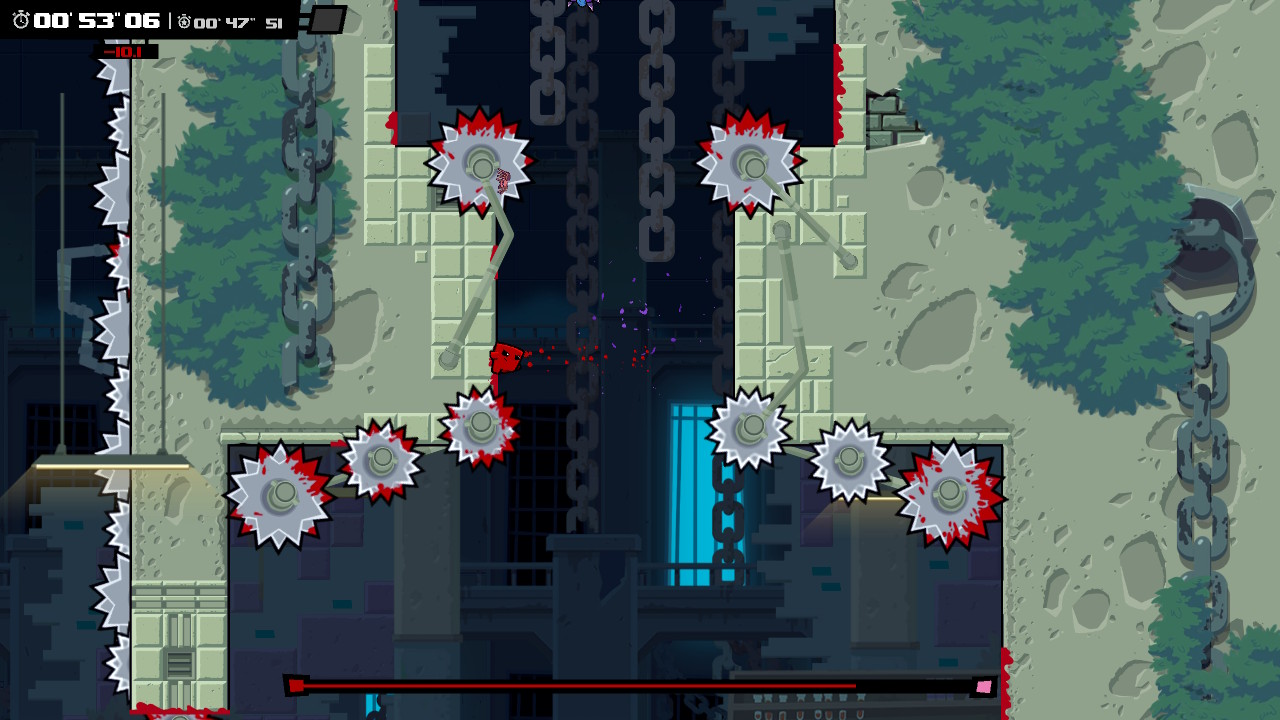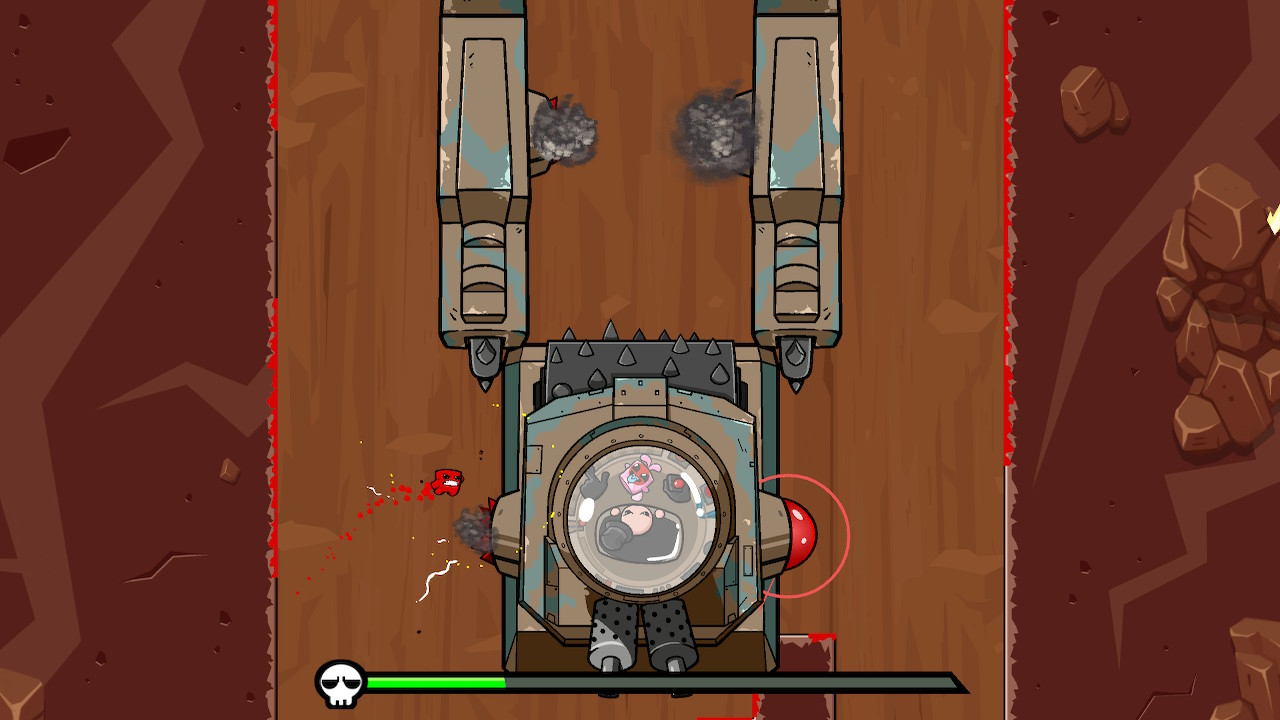
Super Meat Boy Forever
The original Super Meat Boy graced consoles back in 2010, quickly becoming one of the darlings of Xbox Live Arcade (when that was still a thing).
Its release occurred during what was something of a flourishing period for indie games. A slew of novel titles, including the likes of Braid, Castle Crashers, and Shadow Complex were all arriving on Microsoft’s second console, each with their own notable levels of excitement and praise.
Super Meat Boy, an ultra-hard platformer, was no different, and quickly garnered heaps of commendation and awards upon release, soon finding itself on several “Greatest Games of All Time” lists — so no pressure for a sequel then.
If you didn’t play the original (which itself was based on a 2008 Flash game), then this is all you need to know: It’s notoriously tough. The increasingly tricky platforming challenges required plenty of quick thinking, twitchy movements, and countless repeated attempts to get each level done.
The gruelling gameplay of Super Meat Boy was made palatable, and ultimately satisfying, thanks to the super quick gameplay loop. As standard, you’d fail a given level a hundred times, but the game got you back in for another attempt so quickly that you had no time to get seriously mad and give up. This rapid approach at reattempting things gave it an addictive nature — one that so carefully toed the line, just avoiding tipping you into a rage (for the most part at least). As a bonus, when you did finally complete a level you got a hectic replay showing you all of your attempts played back at once. This highlight reel of your failures actually felt like something of a reward, underscoring just how hard you worked to overcome the level that you just wrapped up.
So, a decade after the original launched, we now have a sequel — and it’s fair to say this follow-up has had quite a drawn-out development cycle. First announced back in 2014, it was initially revealed to be a mobile-only auto-runner.
Now, auto-runner games are admittedly well suited to mobile play, offering simplified controls, and quick gameplay, but they aren’t the sort of experience that are typically held in high regard. So, for the celebrated Meat Boy to go in this direction was something of a surprise, if not a little disheartening to some.

In the intervening years since its initial reveal, plans shifted, with Super Meat Boy Forever seeing key personnel changes, development restarts, growing in scope, and eventually becoming a full-on sequel (with console releases now a major focus too) — all whilst retaining that somewhat contentious auto-runner aspect.
The end result is something that’s recognisable on face value, but significantly different in play style.
You are getting more Meat Boy here. This sequel serves up more intense platforming, the same baddy to take on with a similar story, and plenty of tricky environments to navigate — but it’s how you go about manoeuvring your meat (sorry) that’s been massively simplified over the original game.

Gone are the fine-tune controls, instead Meat Boy runs on his own accord, in one direction, with you only having control over his jumps and punches. The auto-runner aspect is fundamental to how this sequel plays. Initially, this limited control scheme didn’t really gel, as I found the restricted motion frustrating, but get a few levels in and you’ll soon forget about what came before, and you’ll take this new experience for what it is.
So, over the course of a dozen worlds (a mix of light and dark — just like the original), you’re challenged to a taxing collection of stages to traverse, all of which require a decent amount of perseverance to get through.
In the original, you had to complete each level in its entirety, in one life, whereas here you have the occasional checkpoint to ease things along. This is due to the way the game is designed — Super Meat Boy Forever opts to do away with set level design, instead going for a more haphazard, procedural approach. Each level is made up of sections, and these sections (which act as checkpoints) are randomised each time you play.
This may sound detrimental to the experience on offer, especially when compared to the meticulous design of the original, but for the most part, I found it actually worked well, and when set side-by-side with the original makes for a less frustrating time overall.
This unarranged approach to level design wasn’t always a winner though, as a couple of times during my play through it served up a sequence of sections that felt a little uneven, resulting in moments where I felt the game wasn’t really respecting my time (all due to these randomised elements throwing up a stinker). However, putting that gripe aside, on the whole, I was pleasantly surprised at how well the procedural level design all ties together. Don’t write it off.
As a quick aside, the levels being sectioned up meant that when it came to finishing a level and getting your replay, it wasn’t anywhere near as satisfying to watch back: as you don’t need to complete a level in one go you won’t see all your attempts at once, instead seeing them broken up over sections.

Once you’ve completed a bunch of levels you’ll face off against a big boss, and it’s here where the game turns things up. Each boss fight is super tough, throwing a new sequence at you to figure out. It’s during these battles that the key to playing this auto-runner sequel becomes really crystallised. In the original, nailing a multitude of skills was expected of you, whereas the main thing you need to get through Super Meat Boy Forever is excellent timing. Once you nail the rhythm of a battle, you’ll get through it. Your patience will vary of course, but this is the key to success.
The boss fights bookend each world and are accompanied by superb cutscenes — honestly, the quality of these vignettes surprised me. Each cutscene has Saturday morning cartoon vibes, with tons of polish. They’re super fun, don’t skip them.

The unlockable characters in the original Super Meat Boy gave things a whole ton of replayability and added flavour, with additional characters bringing in a slew of new play styles. Sadly, the pursuit to unlock new faces in this sequel is mostly an empty one, as they are simply visual skins, adding no unique abilities. Yes, unlocking them is a challenge in and of itself, but the end result is purely an aesthetic one. If you’re ok with chasing mere visual changes, then fill your boots, but it’s not something that added any great appeal for me.
Overall, I was pleasantly surprised by this one. Super Meat Boy Forever struck me as surprisingly inventive, adding an unexpected amount of variety into what, on the surface, may read as a simplified experience. For an auto-runner, it does a great job of mixing things up. You still need to be precise, it still packs a challenge, it’s just different.
Yes, it’s not the game many wanted it to be, and it does feel like it was designed for another time (when auto-runner mobile games were super hot), but it’s a perfectly fine experience in its own right.

I don’t think die-hard fans of the original will immediately warm to this sequel, but if they are willing to give it a shot you’ll find something that’s clearly a labour of love, offering plenty of rock-hard platforming to overcome. Unlike the previous game, I can’t see this ending up on any ‘Greatest Game of All Time’ lists, but if you put ‘second album syndrome’ to one side, this stands alone as a gruelling, masochistic platformer, that feels enough like Super Meat Boy to get a pass.
Don’t let the auto-runner, procedural labels, put you off this one entirely. It’s well worth a shot if you enjoy an extreme challenge.
